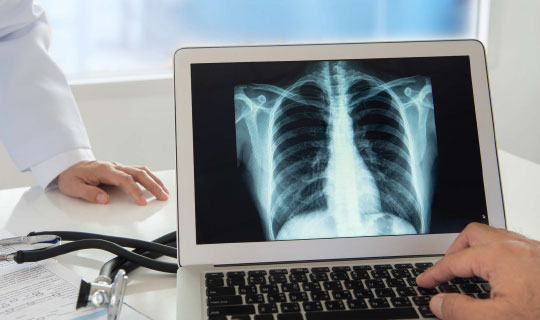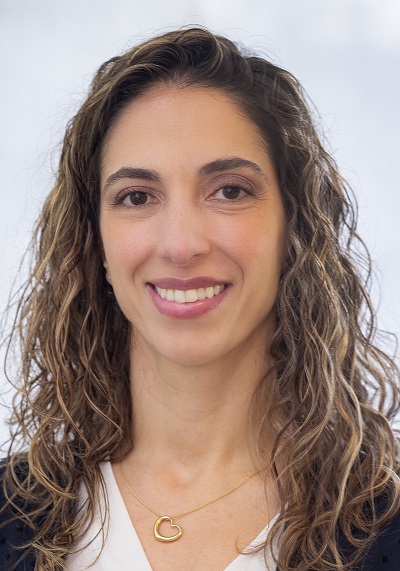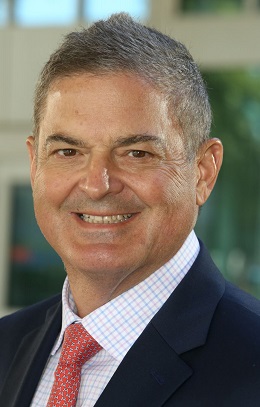
Early detection, advanced technology and a team approach offer improved outcomes.
Lung cancer is the leading cause of cancer deaths in the United States. The good news: State-of the-art early detection, new treatments and sophisticated new technologies— most of which are available across the state at RWJBarnabas Health (RWJBH) and Rutgers Cancer Institute, the state’s only National Cancer Institute-Designated Comprehensive Cancer Center—offer hope for improving outcomes.
Lung cancer is found early—when it’s most treatable—in just one in four cancer patients. RWJBH and Rutgers Cancer Institute have a shared goal: to identify more patients with lung cancer at an earlier stage.
Just as screening can successfully detect breast and colon cancers at early stages, so too can a low-dose computed tomography (LDCT) screening find lung cancer when it is most treatable. Smokers and former smokers between ages 50 and 80 who meet certain criteria are eligible for the LDCT test.

“Unfortunately, in New Jersey, the majority of patients who are eligible for a lung cancer screening do not get one,” says Joanna Sesti, MD, Director of Thoracic Surgery, Northern Region, RWJBH. “It’s important to know that a lung cancer screening can find lung cancer before a patient has any symptoms. And if we catch it at stage 1, we have a 90 percent cure rate.”
The Right Team
Lung cancer testing most often begins when a patient has troubling symptoms and is referred to a specialist who makes the diagnosis.
At RWJBH, the thoracic oncology team and a broad range of specialists participate in weekly multidisciplinary “tumor boards.” In these meetings, all relevant specialties— such as neurology, interventional pulmonology, interventional radiology, gastroenterology and more—discuss each patient’s case.

Specialists who attend tumor boards come from throughout the RWJBH system as well as from Rutgers Cancer Institute.
“Our goal is to get the patient to the right team for treatment close to home as soon as possible,” says Richard Lazzaro, MD, Chief of Thoracic Surgery, Southern Region, RWJBH. “Ultimately, our physicians come to a consensus on the best sequence of treatments for each individual patient.”
Historically, this type of decision making can be a lengthy undertaking as a patient goes from specialist to specialist. “With our multidisciplinary approach, we expedite the process,” Dr. Lazzaro explains. “There are a lot of moving parts, but the approach is sophisticated, well organized, evidence-based and objective.”
Evolving Therapies
Just a few decades ago, treatment for lung cancer was limited to surgery, radiation and certain kinds of chemotherapy.
“Now, since the sequencing of the human genome, there’s a lot more research into identifying mutations in cancers and developing drugs to target those mutations,” Dr. Lazzaro says. “We try to understand what’s going on in the DNA or chromosomes of an individual’s cancer. Is there anything in the molecular pathology report that tells us if a cancer would benefit from a specific, targeted treatment such as immune therapy, which allows the patient’s immune cells to fight cancer cells?”
Modern cancer treatment often involves a variety of modalities. For example, treatment might begin with minimally invasive robotic surgery, from which the patient can recover relatively quickly and begin a course of chemotherapy or immunotherapy.
Advanced new technologies such as the Ion robot-assisted platform for biopsies and the Aliya PEF system for ablating lung lesions are opening even wider horizons for lung cancer treatment.
“The reality is that lung cancer is common—but it is beatable,” Dr. Sesti says. “We have a multidisciplinary team in our region and across the health system to identify and treat it with the best that medicine has to offer. Get your screening; see your doctor.”
New Technology Transforms Care
RWJBarnabas Health (RWJBH) offers two highly advanced technologies for the diagnosis and treatment of lung cancer, available at Monmouth Medical Center (MMC).
Minimally Invasive Lung Biopsies
MMC is one of just two hospitals in New Jersey to have the Ion robot-assisted platform for bronchoscopy, a procedure that lets doctors visualize the inside of a patient’s lungs and airways.
“This is a phenomenal technology,” says Richard Lazzaro, MD, Chief of Thoracic Surgery for the RWJBH Southern Region and a national leader in the field of robotic thoracic surgery. “With Ion, we’re able to take a patient’s CT scan and make a 3-D holographic map. We see the patient’s lungs, trachea, bronchial tubes and any nodules that exist, including those on the surface of the lungs, which a traditional bronchoscopy did not allow us to see.”
Minimally Invasive Ablation
MMC is the first hospital in New Jersey to offer the Aliya PEF system, which is used in conjunction with the Ion robot.
The system delivers high-voltage, high-frequency electrical currents that destroy abnormal cells while preserving surrounding healthy tissue. When Aliya PEF is combined with the Ion technology, diagnosis and treatment can occur in the same procedure.
Life Lessons From Working With Robots
Growing up in a predominantly Hispanic, low-income neighborhood in Hudson County, Joanna Sesti, MD, Director of Thoracic Surgery, Northern Region, RWJBarnabas Health (RWJBH), was turned on to science in high school. She shares key lessons she has learned on the winding road to her success.
- Excellence is possible everywhere. We are building and growing a world-class thoracic surgery program across RWJBH and Rutgers Cancer Institute, the state’s only National Cancer Institute-Designated Comprehensive Cancer Center. I know firsthand how important that is. When my father was diagnosed with renal cell cancer, it required frequent trips to Manhattan. Providing patients with a leading-edge thoracic oncology program with nationally recognized surgeons obviates a need to travel farther than New Jersey to get the highest-quality care.
- There is always a step forward. Progress in minimally invasive robotic thoracic surgery has exploded. Our surgeons can make precise, controlled movements to remove diseased tissue without making large incisions. Advanced techniques offer safe, effective and significantly less painful alternatives to more invasive surgeries for lung cancer—soon to be a thing of the past.
- Math doesn’t care about gender. Female thoracic surgeons are rare, although our numbers are growing. Diversity breeds innovation, and having more capable young women entering competitive fields is necessary. I encourage girls to get involved in science, technology, engineering and math early on and not be afraid of science-heavy fields.
- Science fiction can become fact. I’m excited about new, minimally invasive ablative technologies that use extremely high or low temperatures to destroy abnormal tissue or tumors instead of removing all or part of an organ. There is also wide-ranging potential for employing artificial intelligence and machine learning in thoracic surgery.
- Focus on solutions. Following up on a positive screening test for lung cancer is essential for early intervention. But my colleagues and I have found that minority patients are less likely to return after a positive screening. This is not an easy challenge to fix, but it is where we can make a big difference, so I am determined to stay focused on the solution.
RWJBarnabas Health, in partnership with Rutgers Cancer Institute—the state’s only NCI-Designated Comprehensive Cancer Center—provides close-to-home access to the most advanced treatment options. Learn more about lung cancer at RWJBarnabas Health.
 View full issues of Healthy Together magazine by New Jersey region:
View full issues of Healthy Together magazine by New Jersey region: